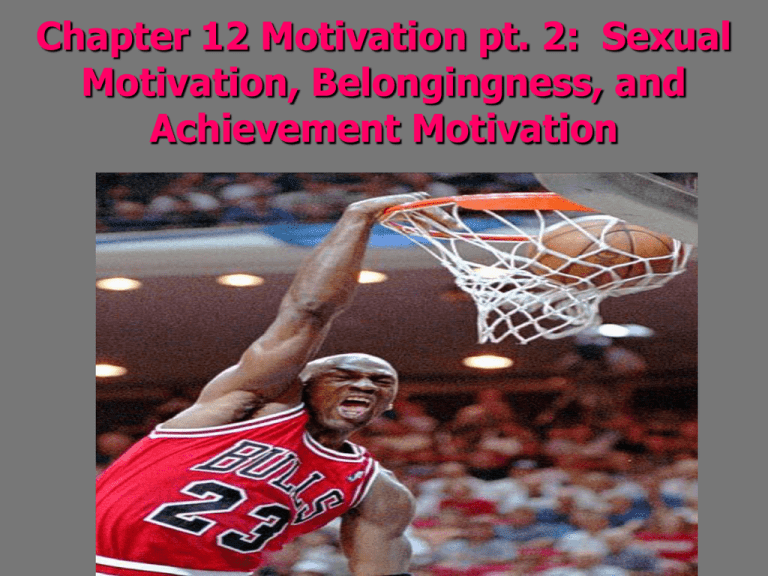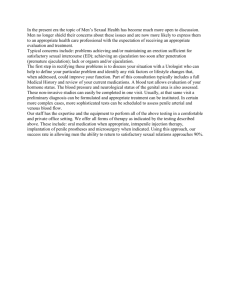
Chapter 12 Motivation pt. 2: Sexual
Motivation, Belongingness, and
Achievement Motivation
Alfred Kinsey
Considered
the father of the
study of human sexuality for
conducting his studies in the
1940’s.
Studies showed that there
were wide variations in
“normal” sexual practices of
individuals and that
premarital sex was
commonplace.
Criticism of Kinsey’s Studies
18,000
people
1940s-1950s
Sample was
unrepresentative
Well
educated whites
Misleading
questions
Sexual Response Cycle
Following
Kinsey’s studies, scientists
looked to identify typical sexual reactions
among volunteers in the 1960’s.
Master and Johnson filmed and identified
the sexual response cycle: refers to
the four stages of sexual response:
1. Excitement
2. Plateau
3. Orgasm
4. Resolution
Sexual Response Cycle
1. Excitement: blood flows to the genital
areas causing both sexes’ genitals to enlarge.
2. Plateau: peak of the excitement phase;
breathing increases; penal and vaginal
secretions increase.
3. Orgasm: ejaculation in the male and
vaginal contractions in the female.
4. Resolution phase: body returns to
unaroused state. In males, enter refractory
period: resting period where they cannot
have another orgasm.
Hormones and Sexual Behavior
Certain
hormones help activate sexual
fertility, putting animals in “heat.”
Females become sexually receptive when
estrogen (sex hormone greater in
females) peaks during ovulation.
Testosterone levels also effect sex drive
in both males and females.
Hormones are monitored by
Hypothalamus.
Effect of External Stimuli on
Sexual Motivation
Studies
have shown that both
males and females are both
aroused by seeing, hearing, or
reading erotic material.
Some psychologists have argued
that sexual explicit materials can
have negative effects. How?
Sexual
Sexual Disorders
Disorders: a problem that
consistently impairs sexual arousal or
functioning.
In Men:
Premature
Ejaculation: ejaculation before
they or their partners wish.
Impotence: inability to maintain an
erection.
In
Women
Orgasmic
Disorder: infrequent or never
experiencing an orgasm.
Cultural Norms Also Have Strong
Impact on Sexual Behavior
40%
Percentage
of births
to unwed
mothers
35
30
25
United States
20
15
Canada
10
5
Britain
0
Japan
1960
1970
1980
Year
1990
2000
Teen Pregnancy
1. Ignorance
2. Guilt related to sexual
arousal/behavior
3. Minimal communication about
birth control
4. Alcohol
5. Mass media “acceptance” of
unprotected sex
http://www.youtube.com/watch?v=RFvRAGs9sSU&safety_mode=true&persist_safety_mode=1&safe=active
Sexual Orientation
Sexual
Orientation: an
enduring sexual attraction
toward members of either
one’s own gender
(homosexual orientation) or
the other gender
(heterosexual orientation)
Possible Causes of Homosexuality?
Have
found brain differences between
heterosexual men and homosexual men
and women. Hard to get at causation.
Identical twin brothers, 52% both will be
gay. Genes not everything.
Prenatal exposure to certain hormones.
Most psychologists believe that nature
more than nurture influences sexual
orientation but the answer has not been
completely solved.
Changing Attitudes towards
Homosexuality
People
who believe homosexuality to be
biological tend to be more accepting.
100%
Extramarital sex is “always wrong”
80
60
Homosexual sex is “always wrong”
40
20
1987
0
1998
Year
Belongingness Motivation
Idea
that humans do not live as
islands are motivated to connect to
others.
Aids Survival
Creates Relationships.
Achievement Motivation
Achievement Motivation: desire to
accomplish things and attaining a high
standard.
2 Types of Achievement Motivation:
1. Intrinsic Motivation: performing task
for its own sake.
2. Extrinsic Motivation: performing task
because of you will receive rewards or
punishments.
Intrinsic vs. Extrinsic
Mom: “I’ll give you $5 for every A.’’
Controlling reward
Child: “As long as she pays,
I’ll study.’’
Extrinsic motivation
Mom: “Your grades were great!
Let’s celebrate by going out
for dinner.’’
Informative reward
Child: “I love doing well.’’
Intrinsic motivation
The Art of Motivating People
Industrial
Psychology: subfield
of psychology that
studies workplace
behavior. Looks to
understand how to
boost productivity and
morale.
Personnel Psychology
Organizational
psychology
Leadership Styles: 2 Types
Task
Leadership: focuses on
goals of organization (the tasks
at hand).
Social
Leadership: group
oriented leadership focused on
relationship building. Teamwork
and mediation of conflict.
Leadership Theories
Theory
X: assumes that workers are
stupid, error prone, and extrinsically
motivated. Need to be directed from
above.
Theory Y: assumes that workers are
motivated to achieve self esteem and
should be challenged and given freedom.





